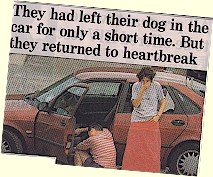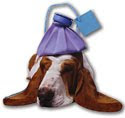Not just a summer problem...
 In
his experience as a veterinarian and a working dog trainer/handler, Dr. Henry de Boer has
attended to far more cases of heat stroke in the spring or fall than he did during the summer
months. Most people are conscious of the risks and predisposing causes of heat stroke in the
summer and take appropriate precautions. Many people, however, drop their guard during other
seasons, which can lead to a possible disaster. Heat stroke is most likely to occur when we are
less conscientious about how heat, muscular exertion and confinement can affect our dogs. In
his experience as a veterinarian and a working dog trainer/handler, Dr. Henry de Boer has
attended to far more cases of heat stroke in the spring or fall than he did during the summer
months. Most people are conscious of the risks and predisposing causes of heat stroke in the
summer and take appropriate precautions. Many people, however, drop their guard during other
seasons, which can lead to a possible disaster. Heat stroke is most likely to occur when we are
less conscientious about how heat, muscular exertion and confinement can affect our dogs.
Q. A friend of mine lost his dog early this spring to heat stroke.
What is heat stroke and how should it be prevented or treated?
A. Heat stroke occurs when the dogís ability to regulate its
body temperature is lost. A dog regulates body temperature primarily through respiration. When
the respiratory tract cannot evacuate heat quickly enough, the body temperature rises. Normal
body temperature is less than 103F, but once the temperature goes over 105F a number of
physiologic events can occur that make it even more difficult for the animal to regain control
of its temperature. At this time, oxygen delivery to the system cannot keep up with rapidly
elevating demand. If the temperature exceeds 108F, cellular damage starts to occur in a number
of organ systems including the kidneys, liver, gastrointestinal tract, heart and brain. The
extent of the cellular damage depends on the magnitude and the duration of the temperature
elevation. Clearly, this can be a life-threatening situation, but for those animals that
survive there is the possibility of long term problems after the occurrence.
 Watch
out Watch
out
There are a number of predisposing factors for heat stroke. Some of the most significant are
listed here:-
- Heat
- Humidity
- Muscular activity
- High body mass
- Anxiety
- Poor ventilation
- Dehydration
- Obesity
- Anti-histamines
- Phenothiazines (some medications for vomiting)
- Brachycephalic breeds (short-nosed breeds)
- Increased age
Symptoms
Dogs experiencing heat stroke will have a muddy pink color of their gums instead of the nice
red-pink color that normally exists. Their heart rate will be dramatically elevated, and they
will be panting furiously. They tend to stand or walk very slowly without regard to where they
are. Some will lay on their sternum. Most dogs will have a wild or panicked expression and are
not particularly aware of their environment.
Any combination of these symptoms should have an owner
scrambling for a rectal thermometer and taking those steps necessary to help drive the
temperature back down. If a thermometer is not available, presume it to be heat stroke and
initiate treatment. If the animal does not respond favorably, the diagnosis can be re-evaluated
later. Significantly delaying the treatment of heat stroke can dramatically increase the risk
of long-term consequences or death.
 Emergency
treatment Emergency
treatment
Heat stroke is an emergency that requires veterinary assistance, but you can effectively
initiate treatment in most cases before heading for the veterinary hospital. You must
aggressively assist the dogsí efforts to lower body temperature with the use of water and air.
Since the lungs cannot keep up with the heat build up, we now have to cool the skin and
associated blood vessels so the bodyís temperature will decrease. Submersion of the dog in cool
water will start to bring the temperature down quickly. You will want to avoid extremely cold
water or ice since they cause the blood vessels in the skin to constrict and will not allow for
a meaningful heat exchange. If there isnít anything available to submerse the dog in, you can
start wetting him down with a hose. Wet him down all over, but let the water run continuously
in the groin area since there are large numbers of significant and relatively superficial blood
vessels in that area that will allow for more rapid cooling of the blood.
The dog should be in
a well-ventilated, shady area to allow for evaporation of the water. Evaporation cools body
temperatures very effectively. When you are transporting him to the veterinary hospital, keep
the air conditioner on or the windows open, or use the back of a truck to increase evaporation.
Do not use an enclosed style crate since it allows for very little evaporation or fresh cool
air for the lungs. Do not cover the dog with a wet towel as it will prevent evaporation.
Once the temperature starts dropping, you should seek
veterinary assistance. It is advisable in most cases to start these animals on intravenous
fluids and monitor kidney and liver function for at least several days. The necessity for this
laboratory work depends on the magnitude and the duration of the elevated temperature, but even
in relatively short mild occurrences, it is a wise precaution to take.
 Prevention Prevention
Obviously prevention of heat stroke is a far better alternative than treatment. Everyone is
aware of the risks of having a dog in a vehicle in the summer, but there are some less obvious
risk factors that we all need to be aware of. Even moderate environmental temperatures can be
very significant when there is little or no ventilation. Heavy muscular activity drives body
temperatures up with alarming speed.
Following intervals of high activity, return the dog to an air conditioned vehicle, or wet the
dog down and go to an area that is shaded and preferably breezy to allow for evaporation. Do
not wet the dog down and return it to an enclosed style crate, as you will be creating a steam
bath like environment. Make sure there is access to reasonable volumes of cool fresh water both
before and after activity. We also need to be conscious of those animals that are at increased
risk, which would include those dogs that have high body mass, older dogs, and those that are
carrying more weight than is normal for them. Being aware of the various risk factors as well
as the environmental considerations should help all of us avoid this potentially devastating
problem.
 About
the author... About
the author...
Dr.
Henry De Boer is the Working K-9 vet. Following his 1973 graduation from Cornell
University, he established Pioneer Valley Veterinary Hospital, based in western Massachusetts,
in 1975.
His involvement with working dogs dates to the mid-1960ís
when he began training and handling hunting dogs. In 1984 he became involved with the sport of
Schutzhund and has gradually risen to the level of national competitor.
Through the years. De Boer has worked both in a training
and veterinary capacity with a wide variety of working dogs. His knowledge and enthusiasm for
working dogs led to the establishment of Working K-9 Veterinary Consultation Services. This
service provides veterinary consultations for working canines and is available by phone, fax,
or email.
Tel./fax: (+01) 802-254 1015. Or visit. http://www.workingk-9vet.com
Picture source: Daily Mail (14 August 1999)
For more informative and easy to use details about
hyperthermia, visit
http://www.working-retriever.com/library/drj/heatpros.html.
From Wendy Cheslea
I found your article to be very interesting.
I make a terry cloth cooler coat for just this
problem. It can be soaked in cold water and placed on the dog for a relaxing and cooling
effect. The coat can also be used for therapy as it has four pockets that sit over the front
shoulders and back area which will hold ice paks or hot paks, whichever is needed. It comes in
various sizes or can be custom made. For more information, contact me at
canine_couture@hotmail.com
(24/06/02)
From Wayne Lehnert
This is taken from an article that was in the Ranch Dog Trainer
(Feb-March 2000) issue Canine Health by Robert Taylor DVM.
When anticipating work in hot humid areas, decrease their
protein intake and increase their fat intake. Fat digestion is more efficient for calorie
production and produces less heat. This can be done by adding 2-4 tablespoons of vegetable oil,
butter or olive oil to their diet.
It also suggest you feed a quality dry food. It also
talks about preconditioning your dog, adequate water and periodic rest periods. A dog that is
overweight may have problems sooner than other dogs.
Good Luck.
|